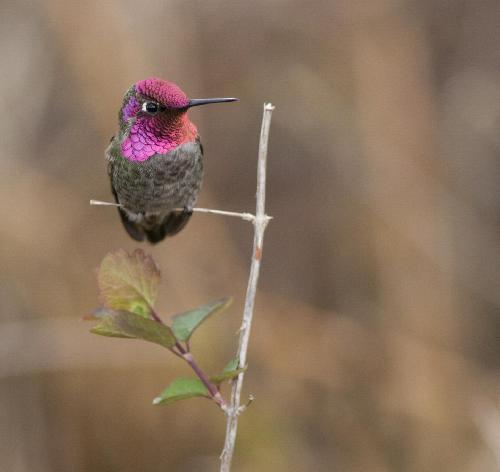Anna's hummingbird from the US west coast has the spangly plumage of a ballroom dancer, could out-maneuver a fighter pilot and can out-hover a helicopter. New research to be published in the journal eLife shows that brute strength is surprisingly important to their abilities.
An intensive study of 20 Anna's hummingbirds, Calypte anna, led by the University of British Columbia, revealed that birds with the highest muscle capacity are able to accelerate faster and make more demanding, complex turns.
"We had expected wing morphology and body mass to have more of an influence on maneuverability so were surprised that muscle capacity is so important," says Doug Altshuler, lead author from the University of British Columbia.

There is little variation in body mass and wing morphology within the species studied, so the scientists will repeat the experiments with other tropical species that have greater variation. These field studies will help determine whether the findings are common to other hummingbirds.
The muscle capacity of the birds was determined by attaching a necklace of weighted beads to each bird. Hummingbirds are able to fly directly upwards, and their maximum weight-lifting ability could be measured by how many of the beads they were able to lift. A two-hour solo flight of each bird was filmed to record and analyse their aerial displays.
The research could find an application in the development of autonomous vehicles.
"A fundamental question is what we should focus on for engineering the autonomous vehicles predicted to be an increasing part of our lives," says Altshuler.
"Our work suggests that for increasing maneuverability, we should focus on increasing the maximum force that the motors are able to produce."
For hummingbirds, the burst capacity of their muscles has an important evolutionary function. Their natural escape response is to fly vertically. They might need to employ this while hovering at a flower to feed. So, in addition to the power needed to hover normally, they need a reserve of power to accelerate away from predators or competitors. Competition within species can be severe, with birds defending a patch of individual flowers for access to nectar and often using their bills as daggers to stab other birds in flight.
Such airborne combat could explain why the birds in the study deployed some extra dazzling moves when paired. These competition trials, filmed over an additional two hours, involved chases, displacements and aerial displays but very little direct contact. Paired birds were found to use more arcing turns than pitch-roll turns in the presence of a competitor. Pitch-roll turns require the birds to slow down, which may make them a target for aggression by a competitor. The scientists believe they prefer arcing terms during competition so that they are always on the move when in flight.
They had expected to see even greater effects of competition, such as higher acceleration. However, they found that the paired birds actually accelerated more slowly during horizontal flight. This may be a result of the experiment being carried out in a chamber rather than in the wild. The benefit of this approach is that a large number of measurements from the same individuals can be combined with other data, allowing the new insights to be uncovered.





Comments